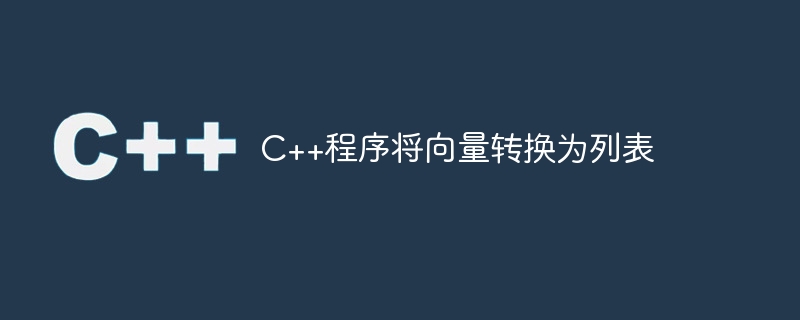
C 中的向量是動態數組,可以包含任何類型的數據,可以是使用者定義的或原始的。動態是指向量的大小可以根據操作增加或減少。向量支援各種函數,資料操作非常容易。另一方面,列表是與向量相同的容器,但與向量的陣列實作相比,列表實作是基於雙向鍊錶的。清單在其中的任何位置都提供相同的恆定時間操作,這是使用清單的主要功能。讓我們來看看將向量轉換為列表的主要方法。
要使用範圍建構函數,在建立列表時必須將向量的起始指標和結束指標作為參數傳遞給建構函數。
vector <int> ip; list <int> op( ip.begin(), ip.end() );
#include <iostream>
#include <vector>
#include <list>
using namespace std;
list <int> solve( vector <int> ip) {
//initialise the list
list <int> op( ip.begin(), ip.end() );
return op;
}
int main() {
vector <int> ip( { 15, 20, 65, 30, 24, 33, 12, 29, 36, 58, 96, 88, 30, 71 } );
list <int> op = solve( ip );
//display the input
cout<< "The input vector is: ";
for( int i : ip ) {
cout<< i << " ";
}
//display the output
cout << "\nThe output list is: ";
for( int j : op ) {
cout << j << " ";
}
return 0;
}
The input vector is: 15 20 65 30 24 33 12 29 36 58 96 88 30 71 The output list is: 15 20 65 30 24 33 12 29 36 58 96 88 30 71
std::list的用法與範圍建構子的用法類似。我們以與範圍建構函數相同的方式傳遞向量的起始和結束指標。
vector <int> ip; list <int> op(); op.assign(ip.begin(), ip.end());
#include <iostream>
#include <vector>
#include <list>
using namespace std;
list <int> solve( vector <int> ip) {
//initialise the list
list <int> op;
op.assign( ip.begin(), ip.end() );
return op;
}
int main() {
vector <int> ip( { 40, 77, 8, 65, 92 ,13, 72, 30, 67, 12, 88, 37, 18, 23, 41} );
list <int> op = solve( ip );
//display the input
cout<< "The input vector is: ";
for( int i : ip ) {
cout<< i << " ";
}
//display the output
cout << "\nThe output list is: ";
for( int j : op ) {
cout << j << " ";
}
return 0;
}
The input vector is: 40 77 8 65 92 13 72 30 67 12 88 37 18 23 41 The output list is: 40 77 8 65 92 13 72 30 67 12 88 37 18 23 41
我們可以使用列表的插入函數將資料從向量插入到列表中。列表需要列表開頭的指標以及向量開頭和結尾的指標。
vector <int> ip; list <int> op(); op.insert(op.begin(), ip.begin(), ip.end());
#include <iostream>
#include <vector>
#include <list>
using namespace std;
list <int> solve( vector <int> ip) {
//initialise the list
list <int> op;
op.insert( op.begin(), ip.begin(), ip.end() );
return op;
}
int main() {
vector <int> ip( { 30, 82, 7, 13, 69, 53, 70, 19, 73, 46, 26, 11, 37, 83} );
list <int> op = solve( ip );
//display the input
cout<< "The input vector is: ";
for( int i : ip ) {
cout<< i << " ";
}
//display the output
cout << "\nThe output list is: ";
for( int j : op ) {
cout << j << " ";
}
return 0;
}
The input vector is: 30 82 7 13 69 53 70 19 73 46 26 11 37 83 The output list is: 30 82 7 13 69 53 70 19 73 46 26 11 37 83
在C 中,將向量轉換為列表具有在列表的任何位置上統一的操作複雜度的好處。有幾種方法可以將向量轉換為列表。然而,我們只在這裡提到了最簡單和最快的方法。
以上是C++程式將向量轉換為列表的詳細內容。更多資訊請關注PHP中文網其他相關文章!




